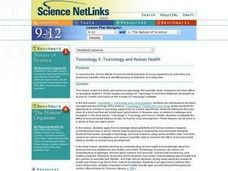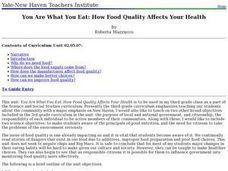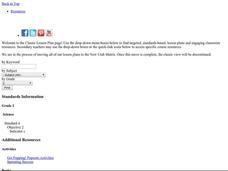Curated OER
Read to Feed
Students participate in the Read-to-Feed project. In this fundraising instructional activity, students read books to purchase a farm animal for a family in need. Students write a letter to the family that will be receiving the farm animal.
Curated OER
The Science and Technology of Food
Students examine the guidelines the United States Department of Agriculture places on food. In groups, they create a list of the foods they consume and discuss the political and environmental implications of purchasing the food. They...
Curated OER
In Case of a Medical Emergency
Studens identify the variety of services available to them at their local medical facilities. In pairs, they role play different conversations that can take place during a medical emergency. High schoolers create a brief description of...
Curated OER
Health and H1N1 Flu Lesson Plans
Health and H1N1 flu lesson plans may be able to help keep students in school and learning.
Curated OER
Consumerism - Grocery Shopping
High schoolers watch a video on how marketers plan their strategies in supermarkets. In groups, they are given a set amount of money and asked to go through a grocery store simulation with a list. After the simulation, they discuss the...
Curated OER
Quick Breads, Muffin Method Demo
Students learn what quick breads are and that they belong to the Bread, Cereal, Grain Food Group on the Food Guide Pyramid which are high in Carbohydrates. They identify characteristics to look for in quick bread products, the...
Curated OER
The Foods we Eat (Los Alimentos)
Sixth graders sing a song and create flashcards showing their favorite foods. For this Spanish "What do you like? lesson, 6th graders display Spanish foods using a document camera and graph their favorites.
Curated OER
Sunlight and Warm Air
Students examine the different ways heat can be felt. In this radiation and conduction lesson, students recognize that the sun radiates heat. Students conduct three experiments to find how the sun warms the Earth and how that heat is...
Curated OER
Chemical Leavening Agents
Discuss leavening agents and baked goods. Describe the purpose of leavening agents in baked goods List the four major leavening agents Explain why baking soda is used with an acid in baked goods Identify the types of doughs and batters...
Curated OER
Heart to Heart
Students examine how social class affects health factors and outcomes by analyzing three case studies of heart attack patients. They reflect on the effects of commodifying health.
Curated OER
Toxicology And Human Health
Students examine the clinical effects of environmental toxicants on living organisms by collecting and analyzing scientific data and identifying ways of detection and diagnosis.
Curated OER
Yeasts and Molds
Students investigate the characteristics and nature of yeast and molds help to explain how these microorganisms affect food production. They experiment with yeast in sourdough in preparing sourdough pancakes.
Curated OER
Self-Fulfilling Prophecy in African American Students: Exploring African American Achievers
Fifth graders are introduced to ways to increase their self-esteem. As a class, they share their specific talents under three categories. In groups, they use the internet to research the lives of various African Americans making sure...
Curated OER
Diet: You Are What You Eat
Third graders examine the issue of food quality to assess the dangers of pesticides, additives, and improper food preparation. After keeping food diaries and categorizing foods, they fill in food pyramids based on their journal entries....
Curated OER
Candy Chemosynthesis
Students explain chemosynthesis and photosynthesis using candy. In this chemosynthesis lesson plan, students work cooperatively to create a visual explanation of the chemical equations of photosynthesis and chemosynthesis.
Curated OER
Woman Power!!! Mathematics Camp
Students explore mathematics by researching stereotypes. In this gender bias instructional activity, students participate in discussions where they identify traditional careers according to their own gender. Female students attend summer...
Curated OER
Insects!
Students explore the diet of insects. In this "insects" biology lesson, students take a nature walk and collect various natural materials they think may be eaten by insects. Students sort and classify these materials into three diet...
Curated OER
A Recipe for Reading: Asian Style Rice and Eggs
Learners read, write about, and cook with rice in this home economics lesson plan. They reflect on the experience eating rice at home or in other ethnic foods.
Curated OER
A World of Taste--Louisiana Gumbo
Students discover the multicultural contributions to New Orleans gumbo through participation in cross curriculum activities. In this multicultural diversity and New Orleans history lesson, students shade regions of a map according to a...
Curated OER
History in the Making: The Tortilla
Fourth graders examine the history of the tortilla and extend the study across the curriculum. In this history of the tortilla lesson, 4th graders research the background of the tortilla, determine the ingredients, and work with the...
Curated OER
Vermicomposting
First graders investigate composting. In this biology lesson plan, 1st graders identify ways to use garbage as fertilizer. Students examine soil and compost matter as well as the role of worms in the dirt.
Curated OER
Fable of the Fainting Goat
Second graders explore animal life by reading children stories in class. In this goat fable lesson, 2nd graders read several books which describe the different myths and folklore about goats. Students identify the needs of living animals...
Curated OER
My Little Seed House
Second graders explore plant life by participating in a germination activity. In this botany lesson, 2nd graders read several books about seed germination including Sunflower House and Tiny Seed. Students identify the necessary elements...
Curated OER
Vermicomposting
Second graders create an eco-bin and study the habitat of the worm in soil. For this vermicomposting lesson, 2nd graders observe the effects of water ( too much or too little) and other factors on the eco-bin.

























